‘Neer’ (nest) is a vacation house in Sylhet, Bangladesh, which reflects the client’s emotion of returning to his root through the architecture and space. The topography of the land with the scenic surroundings and water on the eastern side creates a dominant feature in a context.

It acts as a symbol of memory and belongingness that behaves as a traditional village. The space is replicated with the clients’ childhood memories and respecting his love of nature. It is a house that floats on a plinth and not disturbing the nature is a key concept of the project. Preserving the years old trees within the site, whereas the trees penetrate the roofs as it felt necessary. The nature guides the build form and the shape of the building. Micro climate is considered, where the site force is carefully dealt with.


Private and public functions are organised and a multifunctional outdoor space is provided for communal gatherings. The flow of the build form respecting the contour and materials of the walls blended with the surroundings. As the site flows and so does the house with the trees and capture the views of the huge pond. The spatial quality of the space echoes the spirit of the site while the suspended floor of the living area welcomes for multi activities. Bedrooms are embedded in the northern side of the forest area. The roof follows and open up the eastern end to catch the early sunlight and wind. The tree like structures that supported the roof where shaded space and the green space merged. A central courtyard acts as a focal point and creates a transition between the spaces.






This allows the natural flow of air to thrive and enhancing the contract between the built space and nature, improves the micro climate of the site that amplifies the cooling effect. It ensures the house is naturally ventilated. Since it will be used for a limited time of a year, the screens/jalis have been used to ensure the flow of air even the doors are locked for a time of the year. The public areas towards the east are porous verandahs with deep roof overhangs. It protects from the sun and the rain but allowing the continuous movement of the breeze with the trees. The private bedrooms are banked in the north-south direction which allows the ample sunlight and air overlooking the main streets that buffered with the dense forest. Two wings of the public and private zones divided with the main entrance followed the courtyard which leads to the dining area. The upside hills of the west sides create shades and shield the house from the afternoon sun.
Behind The Lens: Asif Salman, Salarchman Studio




Copyright © 2025 ArchBiz Magazine. All Rights Reserved.





